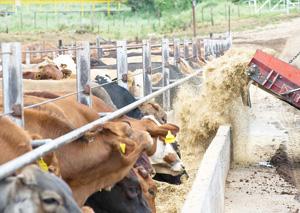
Dune Tannery contributes to community

Lydia Strauss tanning the skin. Photograph by Treasure Kauzuu
Situated 10 kilometres from the B1 road north-east of Kalkrand in the Hardap region, Duineveld is a small settlement area in the Rehoboth district and was rated by the 2011 Census report as one of the poorest constituencies in the Hardap region.
“I am motivated to work because at my age I refuse to just sit around at home and do nothing.
Working keeps the old-age at bay and besides am used to keeping busy and am used to being independent,” she said. According to Lydia, the community respects and looks up to her and she is often complimented for her work especially because of her age.
“Some of my peers are reluctant to work but at least some try to earn a living,” she added. Saying that her colleagues are very supportive of whatever work she does at the tannery.
Lydia is a tannery specialist who previously worked as a cashier at a retail shop in Windhoek before moving to Duineveld. She said that she got the skills to work with skin products from her parents during her childhood, but says that in the olden days, people worked with hands and not with machines like today.
In 2012, Lydia received three weeks training from Nakara to upgrade her skills. She says although her salary is fairly low, it is sufficient enough for her to cope because her husband is also employed and her children are old enough to cater for themselves.
Being the oldest tannery in the southern region, Dune Tannery is one of the most successful projects in the constituency. Lydia is not the only one however to reap benefits of the tannery.
Local community women who are also involved in the production of the materials, weave patch designs on finished materials. They are then paid between 20 to 30 % from the total selling price of the finished material.
The tannery has six other employees and one casual worker.
The skins used at the tannery include springbok, sheep and goat skins. The tannery’s vision is to empower the community of Duineveld especially children and those living with HIV/AIDS.
According to the Chairperson of the Dune Tannery, Sonia de Klerk, Duineveld is one of the lowest income generating communities. “We want to assist the community through the tannery by assisting families that are impoverished in order to sustain themselves in future,” she said.
The Dune Tannery was established in 1994 but officially started operating in 1996. According to de Klerk, the tannery only had one small milling drum but eventually managed to acquire sponsorship from the Millennium Development Fund in 2008 which sponsored the project with N$200 000.
In 2012, the project received funding of N$1.4 million and expanded its premises with some of the money. Approximately N$ 900,000 from the funding was used to buy a bigger milling drum used to soften the skin as well as a tanning drum to tan the skin. In 2013, the Dune Tannery received another sponsorship of N$ 130,000 worth of raw skins and chemicals from the Ministry of Trade and Industry.
The factory is run by the community but supervised by the Community Development Council. According to Sonya, many of the employees did not attend formal schooling but were given training by line ministries such as the Ministry of Youth, National Service, Sports and Culture.
The employees received training in courses such as Business management and information technology which were facilitated by UNAM lecturers. They also received Governance and leadership training in 2012.
She said although clients are few, they often exhibit their products at trade fairs and at the Craft Centre in Windhoek.
The Dune Tannery products can also be seen displayed alongside the B1 road between Kalkrand and Rehoboth.











































